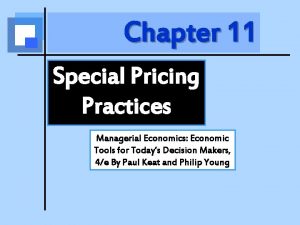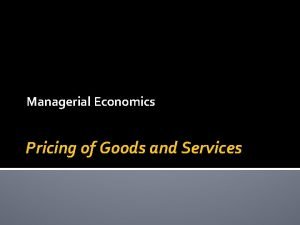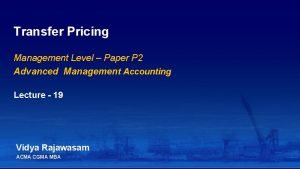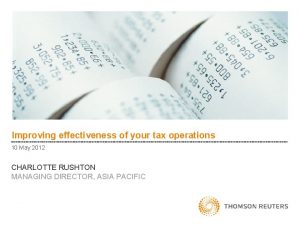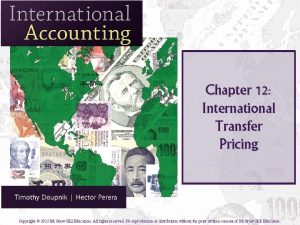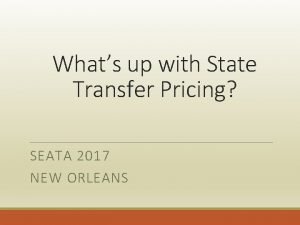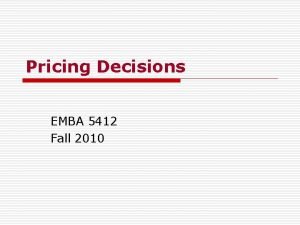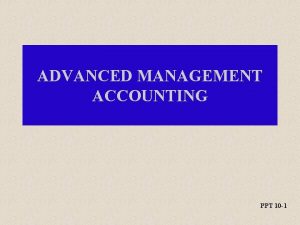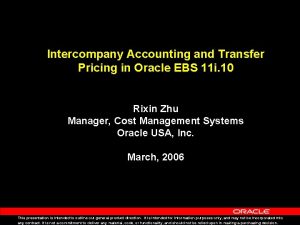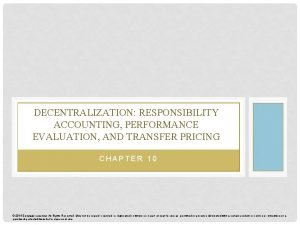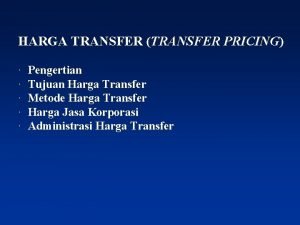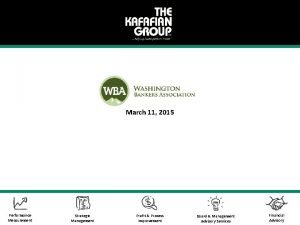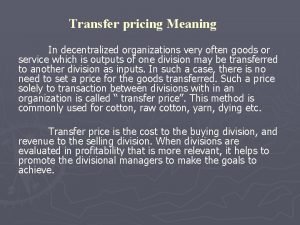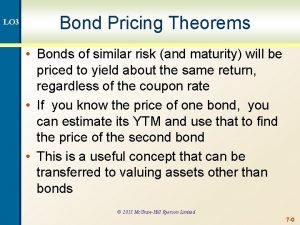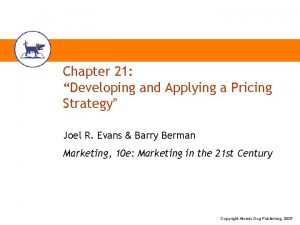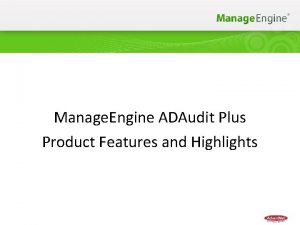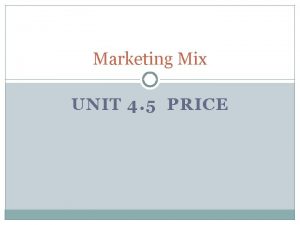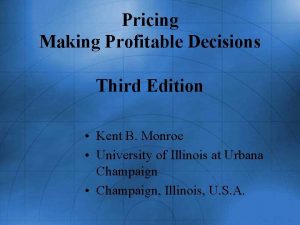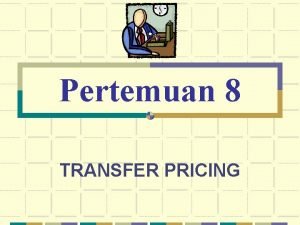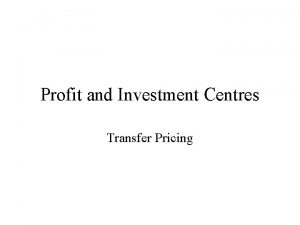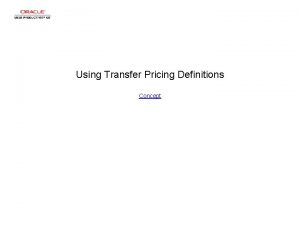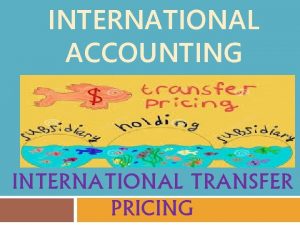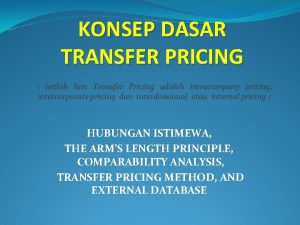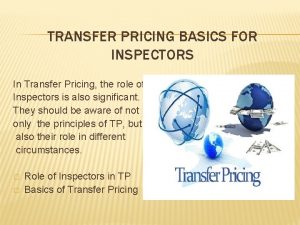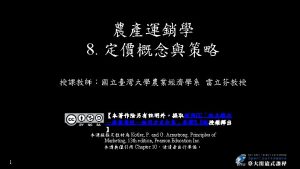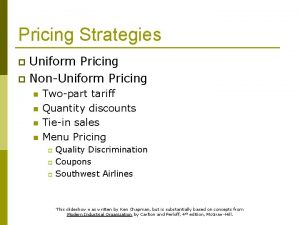Transfer Pricing What is Transfer Pricing Transfer pricing














![Comparable Uncontrolled Price Method [Rule 10 B(1)(a)] • • • Considered the most preferred Comparable Uncontrolled Price Method [Rule 10 B(1)(a)] • • • Considered the most preferred](https://slidetodoc.com/presentation_image_h2/c4a5efdebf731b0aeb3174c5a0405550/image-15.jpg)


![Cost Plus Method [Rule 10 B(1)(c)] • Applicable when an enterprise is engaged in Cost Plus Method [Rule 10 B(1)(c)] • Applicable when an enterprise is engaged in](https://slidetodoc.com/presentation_image_h2/c4a5efdebf731b0aeb3174c5a0405550/image-18.jpg)
![Profit Split Method [Rule 10 B(1)(d)] • Appropriate for transactions which are not capable Profit Split Method [Rule 10 B(1)(d)] • Appropriate for transactions which are not capable](https://slidetodoc.com/presentation_image_h2/c4a5efdebf731b0aeb3174c5a0405550/image-19.jpg)









- Slides: 28

Transfer Pricing

What is Transfer Pricing • Transfer pricing refers to the pricing of cross-border transactions between two related entities. • When two related entities enter into any crossborder transaction, the price at which they undertake their transaction is called transfer price. • Due to the special relationship between related companies, transfer price may be different than the price that would have been agreed between two unrelated companies.

Why Transfer Pricing • TP manipulation can affect the tax liability of an individual or group of persons/ entities. • Cash flow requirements of MNE groups. • Price flexibility between associated enterprises. • Factors responsible for TP Misreporting- UN TP 2017: ØRapid advances in technology, transportation and communication. ØExistence of tax heavens and tax friendly jurisdiction. ØDominance of MNCs in World trade. ØRise of Service sector.

Provisions- An Overview

Applicability • The provisions of Section 92 to 92 F of the Act are applicable only if: ØThere are two or more enterprises (defined in Sec 92 F); and ØThe enterprises are AEs (defined in Sec 92 A); and ØThe enterprises enter into a transaction (defined in Sec 92 F); and ØThe transaction is an International transaction (defined in Sec 92 B). • Further w. e. f. 01 April 2012, TP provisions shall also apply to Specified Domestic Transactions (SDTs) (defined in Sec. 92 BA). • Consequences of these provisions: ØComputation of Income/ allowance of expenses having regard to the Arm’s length price [Section 92 BA]. ØMaintenance of prescribed Documentation (Section 92 D & Rule 10 D). ØObtaining of Accountant’s report (under Form 3 CEB) (Section 92 E). ØTo ensure compliance with the arm’s length principle, stiff penalties have been prescribed.

• Section 92(1): Any income arising from an international transaction shall be computed having regard to the arm’s length price. Explanation - the allowance for any expense or interest arising from an international transaction shall also be determined having regard to the arm’s length price. • Section 92(3): The provisions are not intended to be applied in case determination of arm’s length price reduces the income chargeable to tax or increases the loss as the case may be.

Associated Enterprise- Meaning (Section 92 A) • Associated enterprise means an enterprise which directly or indirectly participates through one or more intermediaries in the management, control or capital of the other enterprise. For example:

Deemed Associated Enterprise (Section 92 A) HOLDING MANAGEMENT ACTIVITIES CONTROL 1. >=26% direct/indirect holding by enterprise. OR 2. By same person in each enterprise 1. Appointment > 50% of Directors/ one or more Executive Director by an enterprise. OR 1. 100% dependence on use of intangibles for manufacture/ processing/ business. 1. One enterprise controlled by an individual and the other by himself or his relative or jointly. 3. Loan >=51% of Total assets 2. Appointment by same person in each enterprise 2. Direct/indirect supply of >=90% Raw materials under influenced prices and conditions 2. One enterprise controlled by HUF and the other by member of HUF or his relative or jointly. 4. Guarantees>= 10% of debt 5. >10% interest in Firm/AOP/BOI 3. Sale under influenced prices and conditions

International Transaction (Section 92 B) • Transactions between two or more AEs, either or both of whom are nonresidents. • Transaction relates to: ØPurchase, sale or lease of tangible or intangible property; ØProvision of services; ØLending or borrowing money; or ØAny other transaction having a bearing on the profits , income, losses, or assets of the company ; or ØMutual agreements or arrangements for allocation or apportionment of, or any contribution to, any cost or expense incurred; or ØBusiness restructuring or reorganization irrespective of fact that it has bearing on the profits, income, losses or assets.

Specified Domestic Transaction (Section 92 BA) • Any of the specified transactions, not being any international transaction, namely: ØTransaction referred to in Section 80 A; ØTransfer of goods or services referred to in sub-section(8) of Section 80 -IA; ØAny business transacted between the assessee and other persons as referred to in sub-section (10) of section 80 -IA; ØAny transaction, referred to in any other sections under Chapter VI-A or Section 10 AA, to which provisions of sub-section (8) or sub-section (10) of section 80 -IA are applicable; ØAny other transaction as may be prescribed (NOTE: The provisions of Section 92 BA i. e. Specified Domestic Transaction would be applicable if the aggregate value of transactions entered into by assessee in the previous year exceeds INR 20 crores. )

Concept:

Arm’s Length Price: • Price applied or proposed to be applied in a transaction between persons other than associated enterprises, in uncontrolled conditions. • Determination of arm’s length prices using one of the Prescribed method. YES The price thus determined is arm’s length price. Whether arrived at a single price? NO The arithmetic mean of such prices or a price which varies from such arithmetic mean by +/- 3% (or 1% as the case may be) is the arm’s length price (92 C(2)). It is pertinent to note that the range concept has been introduced vide Finance Act, 2014

Prescribed Transfer Pricing Methods Resale Price Method Comparable uncontrolled price Cost plus Method Traditional Transaction Method Transactional Net Margin Method Profit Split Method Transactional Profit Method

Selection of Most appropriate Method (Rule 10 C) • Following factors should be taken into account: ØNature and class of the international transactions. ØThe class of associated enterprises entering into the transaction and the functions performed by them taking into account assets employed and risks assumed by such enterprises. ØAvailability, coverage and reliability of data necessary for application of method. ØDegree of comparability existing between the international transaction and between the enterprises entering into such transactions. ØThe extent to which reliable and accurate adjustments can be made on account of any differences between the international transactions and the comparable uncontrolled transaction or the enterprises entering into these transactions. ØThe nature, extent and reliability of assumptions required to be made in application of a method.
![Comparable Uncontrolled Price Method Rule 10 B1a Considered the most preferred Comparable Uncontrolled Price Method [Rule 10 B(1)(a)] • • • Considered the most preferred](https://slidetodoc.com/presentation_image_h2/c4a5efdebf731b0aeb3174c5a0405550/image-15.jpg)
Comparable Uncontrolled Price Method [Rule 10 B(1)(a)] • • • Considered the most preferred method, for all transactions, if information is available. Compares the price charged in a controlled transaction with the price in an uncontrolled transaction. Comparable can be ‘internal’ or ‘external’. Requires strict comparability in products, contractual terms, economic terms, etc. Most direct and accurate method. Applicability: • • Transfer of tangibles i. e. standard products/ goods. Use in case of strong similarity of products.

Comparable Uncontrolled Price Method 2. Such price adjusted to account for differences if any between international transaction and uncontrolled transaction(s) 1. Identification of price charged or paid in comparable transaction(s) 3. Adjusted price arrived above taken to arm’s length price Comparable Uncontrolled Price Method

Resale Price Method- Rule 10 B(1)(b) • To be used when purchases from AE for resale purposes. • Compares the resale gross margin earned by an associated enterprise with the resale gross margin earned by comparable independent distributors. • An arm’s length gross margin should be sufficient for a reseller to cover its operating expenses and make an appropriate operating profit (in light of its functions and risk). • Preferred method for a distributor buying purely finished goods from a group company without any value addition.
![Cost Plus Method Rule 10 B1c Applicable when an enterprise is engaged in Cost Plus Method [Rule 10 B(1)(c)] • Applicable when an enterprise is engaged in](https://slidetodoc.com/presentation_image_h2/c4a5efdebf731b0aeb3174c5a0405550/image-18.jpg)
Cost Plus Method [Rule 10 B(1)(c)] • Applicable when an enterprise is engaged in manufacturing activity or provision of services, sells such goods or renders such services to AEs. • Direct and indirect cost of production of property transferred or service provided is determined. • Compares the gross profit on costs the associated enterprise earns with the gross profit on costs earned by comparable independent companies. • Preferred method for: ØManufacturer supplying semi finished goods. ØCompany providing services
![Profit Split Method Rule 10 B1d Appropriate for transactions which are not capable Profit Split Method [Rule 10 B(1)(d)] • Appropriate for transactions which are not capable](https://slidetodoc.com/presentation_image_h2/c4a5efdebf731b0aeb3174c5a0405550/image-19.jpg)
Profit Split Method [Rule 10 B(1)(d)] • Appropriate for transactions which are not capable of being evaluated separately. • Calculates the combined operating profit resulting from a whole inter-company transaction based on the relative value of each associated enterprise's contribution to the operating profit

Profit Split Method • Determination of combined net profit of the associated enterprise arising out of international transaction. • Evaluation of relative contributions by each enterprise on the basis of functions performed, risks assumed and assets employed. • Splitting of combined net profit amongst enterprises in proportion to their relative contributions. • Profit thus apportioned to the tested party is used to arrive at the arm’s length price.

Transactional Net Margin Method- Rule 10 B(1)(e) • • • Examines net operating profit from transactions as a percentage of a certain base (can use different bases i. e costs, turnover, etc) in respect of similar parties. Ideally, operating margin should be compared to operating margin earned by same enterprise on uncontrolled transaction. Applicable for any type of transaction and often used to supplement analysis under other methods. Most frequently used method in India, due to lack of availability of comparable uncontrolled prices and gross margin data required for application of the comparable uncontrolled price method/ cost plus method/ resale price method. TNMM can be internal or external. Internal TNMM refers to transaction between AEs and unrelated parties whereas External TNMM refers to transactions between third parties. Internal TNMM is preferred over external TNMM as it provides more reliable and accurate data for comparison.

Sixth Method- Rule 10 AB “Rule 10 AB - For the purposes of clause (f) of sub-section (1) of section 92 C, the other method for Determination of the arms' length price in relation to an international transaction shall be any method which takes into account the price which has been charged or paid, or would have been charged or paid, for the same or similar uncontrolled transaction, with or between non associated enterprises, under similar circumstances, considering all the relevant facts. “ • Operative from 1 April 2012 and applicable from AY 2012 -13. • CBDT does not provide either clarity or guidance in terms of the manner of benchmarking a transaction under this method.

Indian TP Regulations • Section 92 E provides as under: “Every person who has entered into an international transaction during a previous year shall obtain a report from an accountant and furnish such report on or before the specified date in the prescribed form duly signed and verified in the prescribed manner by such accountant and setting forth such particulars as may be prescribed. ” • Form 3 CEB must be obtained by every tax payer filing a return in India and having international transaction or SDT. • To be filed by due date for filing return of income (i. e 30 November). • Non filing of Form 3 CEB may give rise to following penal consequences: ØPenalty under Section 271 AA at the rate of 2% of the value of each international transaction for non reporting of transaction. ØPenalty under Section 271 BA of 100, 000 for non filing of Form 3 CEB.

Particulars under Form No. 3 CEB- Part A • List of associated enterprises with whom an assessee has entered into international transactions, with the following details: ØName, address, PAN of the associated enterprise. ØNature of business or activities of the assessee (code for nature of activity to be filled as per instruction for filing the ITR-6). ØAggregate value of International transactions as per books of accounts. ØAggregate value of specified domestic transaction as per books of accounts.

Particulars under Form No. 3 CEB- Part B • Information needs to be given regarding the following transactions: ØList of AEs with whom assessee has entered into international transactions, the relationships between them and their business activities in brief. ØPurchase/Sale of Raw materials, consumables or any other supplies for assembling/ processing/ manufacturing of goods/articles. ØPurchase/sale of traded/ finished goods. ØPurchase/ sale of any other tangible movable/ immovable property or lease of such property. ØPurchase/sale/use of intangible property such as know-how, patents, copyrights, licenses etc. ØProvision of services. ØLending or borrowing money ØOther mutual agreements ØAny other transactions.

Particulars under Form No. 3 CEB- Part C • In relation to Specified Domestic Transactions: ØName, address and PAN of the associated enterprises. ØNature of relationship. ØBrief description of the business carried out by the associated enterprises. ØTransactions disclosures. ØEligible business referred to in section [80 A(6), 80 IA(8) or 10 AA)] transferring / acquiring any goods or services to/ from any other business carried on by the assessee. ØAny specified domestic transaction(s) resulted in more than ordinary profits to an eligible business to which section 80 IA(10) or section 10 AA applies. ØAny other specified domestic transaction not specifically referred to the above.

Transfer Pricing Documentation (Rule 10 D) Entity Related Price Related Analysis Related Supporting Documents Ownership structure Nature & terms (incl. prices) Record of uncontrolled transactions. Market research reports by reputed institutions. Profile of MNC group FAR analysis Methods considered for ALP Price publications incl. stock market quotations Description of business & the industry Economic and market analysis incl. forecasts and budgets Comparability analysis Contracts with AE or unrelated parties Published Financials of Associate enterprise Workings of ALP Correspondence with AE The assumptions, policies, and price negotiations. ALP Details of adjustments made Any other information relevant for ALP

THANK YOU
 Oecd business restructuring
Oecd business restructuring Transfer pricing example
Transfer pricing example Pricing practices in managerial economics
Pricing practices in managerial economics Pricing methods in managerial economics
Pricing methods in managerial economics Transfer pricing example
Transfer pricing example Transfer pricing
Transfer pricing Importance of transfer pricing
Importance of transfer pricing Multi-state transfer pricing analysis
Multi-state transfer pricing analysis Transfer pricing examples
Transfer pricing examples Global transfer pricing survey
Global transfer pricing survey Role of management accounting ppt
Role of management accounting ppt Oracle transfer pricing
Oracle transfer pricing Responsibility accounting and transfer pricing
Responsibility accounting and transfer pricing Pengertian transfer pricing
Pengertian transfer pricing Wu transfer pricing center
Wu transfer pricing center Fund transfer pricing
Fund transfer pricing Transfer price meaning
Transfer price meaning What is disturbance that transfers energy
What is disturbance that transfers energy Bond pricing theorems
Bond pricing theorems Zetafax server
Zetafax server Demand based pricing
Demand based pricing Manageengine admanager competitors
Manageengine admanager competitors Advantages of destroyer pricing
Advantages of destroyer pricing Chapter 26 pricing strategies answer key
Chapter 26 pricing strategies answer key Developing pricing strategies and programs
Developing pricing strategies and programs Andrew popov
Andrew popov Optional product pricing
Optional product pricing Pricing: making profitable decisions
Pricing: making profitable decisions Reverse cost plus pricing
Reverse cost plus pricing


